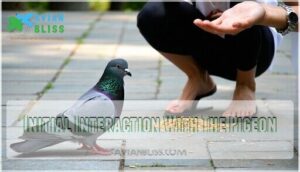This site is supported by our readers. We may earn a commission, at no cost to you, if you purchase through links.

Start by placing food near the bird while maintaining distance.
Gradually move closer each day as the pigeon becomes comfortable with your presence.
Use seeds or breadcrumbs to create positive associations with you.
Speak softly and move slowly to avoid startling the bird.
Once it accepts food from nearby, slowly extend your hand with treats.
This process typically takes 5-7 days with regular sessions.
The key is respecting the pigeon’s comfort zone while building trust through food rewards.
Understanding their natural behaviors and stress signals makes all the difference in creating a successful bond.
Table Of Contents
- Key Takeaways
- How to Tame Wild Pigeon?
- Understanding Pigeon Behavior
- Preparations for Taming a Pigeon
- Initial Interaction With The Pigeon
- Building Trust With The Pigeon
- Progressing With Taming
- Challenges and Solutions
- Long-term Bonding and Enrichment
- Taming Timeline
- Frequently Asked Questions (FAQs)
- My pigeon is not coming out of the cage. What should I do?
- Is it possible to tame a wild pigeon?
- Can wild pigeons be friendly?
- Is it okay to pick up a wild pigeon?
- How to get a wild pigeon to trust you?
- Can I keep a wild pigeon as a pet?
- Can You tame a wild pigeon?
- How do you tame a pigeon?
- How long does it take to tame a pigeon?
- Can you release a tamed pigeon back into the wild?
- Conclusion
Key Takeaways
- Start with daily feeding from a distance – Place seeds 10-15 feet away and gradually move closer each day as the pigeon becomes comfortable with your presence.
- Use patience and consistency – Maintain regular feeding schedules and gentle movements over 5-7 days, as sudden actions will trigger their flight response and undo progress.
- Build trust through food rewards – Safflower seeds and peanuts create positive associations with you, eventually allowing hand-feeding and physical contact.
- Respect the bird’s comfort zone – Watch for stress signals like feather ruffling and rapid breathing, backing off when needed to maintain the trust you’ve built.
How to Tame Wild Pigeon?
Taming wild pigeons starts with understanding pigeon psychology and creating trust through patience.
You’ll establish a quiet, safe space and use food rewards to build positive associations. This process requires respecting the bird’s natural instincts while gradually introducing human contact.
One way to deter pigeons from unwanted areas is to use reflective visual deterrents.
Successful pigeon taming offers companionship benefits, though ethical considerations and legal aspects vary by location. Always research local regulations before befriending pigeons, as release strategies may be necessary.
Understanding Pigeon Behavior
Before you can successfully tame a wild pigeon, you need to understand how these birds naturally behave and think.
Recognizing their instincts and stress signals will help you approach them in ways that build trust rather than create fear, by understanding their natural behavior and stress signals.
Natural Instincts and Behaviors of Pigeons
Wild pigeon behavior stems from evolutionary adaptations that help them survive in complex environments.
Understanding pigeon instincts is your first step toward successful bonding with these naturally cautious urban birds.
These natural instincts directly influence how you’ll approach taming wild pigeons successfully.
- Flocking behavior: Pigeons feel safer in groups, making solo birds more receptive to human contact
- Communication methods: They use soft coos and body language to signal comfort or distress
- Navigation skills: Built-in compass abilities make them confident explorers of new territories
- Feeding habits: Ground foragers who associate food sources with safety and return repeatedly
- Roosting sites: They prefer elevated perches that offer clear views and quick escape routes
Signs of Stress or Fear in Pigeons
Spotting pigeon stress signals helps you adjust your approach during taming.
Watch for feather ruffling, rapid breathing, and wing flicking when birds feel threatened.
Avoidance behavior like backing away or flying short distances shows discomfort.
Changes in vocalizations – from normal cooing to sharp alarm calls – indicate fear.
Understanding wild pigeon behavior lets you apply pigeon calming techniques effectively, creating better taming conditions.
Preparations for Taming a Pigeon
Before you start taming a wild pigeon, you’ll need to create the right setup and gather essential supplies.
Proper preparation makes the difference between success and frustration, so choose a quiet location away from distractions.
Stock up on high-quality seeds like safflower or Spanish peanuts that pigeons find irresistible.
Choosing The Right Environment
The suitable environment plays a vital role in taming wild pigeons successfully.
Choose a quiet, secluded area away from heavy foot traffic and loud noise levels to minimize stress.
Your space needs predator protection from cats, hawks, and other threats.
Consider aviary size requirements – outdoor enclosures should measure at least 7×4 feet for multiple birds.
Indoor caging works for single pigeons but requires proper ventilation.
Adding natural elements like perches and water features creates a calm environment that encourages pigeon trust building and smoother pigeon socialization during the taming process.
Necessary Supplies for Taming
Before taming wild pigeons, you’ll need specific supplies for successful pigeon trust building.
Secure a spacious cage with proper Aviary Size dimensions and small bar spacing. Stock quality Food Quality treats like safflower seeds for feeding wild pigeons.
Install varied Perch Types and reliable Water Source access. Keep Cleaning Supplies handy for maintenance.
For proper hydration, consider investing in pigeon drinking solutions. These essentials support effective pigeon training tips and pigeon socialization throughout your taming journey.
Initial Interaction With The Pigeon
Your first interaction with a wild pigeon requires careful patience and respect for the bird’s natural wariness.
Start by positioning yourself at least 10-15 feet away from the pigeon and move slowly to avoid triggering its flight response, which can activate from distances up to 30 meters when the bird perceives a threat.
Approaching The Pigeon Safely
Once you’ve prepared your environment, approaching the pigeon becomes your next challenge. Your success depends on mastering the delicate art of non-threatening movement around these naturally cautious birds.
Here’s your safe approach strategy:
- Maintain safe distance of 10-15 feet initially to avoid triggering flight responses
- Use slow movements – sudden gestures activate their predator-alert instincts instantly
- Keep calm demeanor with relaxed posture and quiet presence throughout interactions
- Avoid direct threats like overhead reaching or cornering the bird unnecessarily
Your body language speaks volumes to pigeons. They read tension in your shoulders and interpret quick motions as danger signals.
Understanding their social and communication is key to building trust. Building trust with taming wild pigeons requires patience and respect for their comfort zones during these critical first encounters.
Observing and Respecting The Pigeon’s Comfort Zone
Watch for three key behavioral signals during pigeon observation.
Maintain a safe distance of at least ten feet initially, allowing the bird to assess your presence without triggering flight responses.
Read their body language carefully—relaxed postures indicate comfort, while hunched shoulders or rapid head movements signal stress.
Use quiet approach methods with slow movements, avoiding direct stares that pigeons interpret as predatory behavior during taming sessions.
Building Trust With The Pigeon
Building trust with a wild pigeon requires patience and consistent positive interactions that respect the bird’s natural wariness.
You’ll need to use food rewards, maintain calm behavior, and gradually introduce physical contact to transform fear into familiarity.
Using Food to Bond
Food rewards foster pigeon trust fast. Hulled sunflower seeds and safflower seeds work best for taming pigeons.
Trust builds fastest when pigeons associate your presence with their favorite treats.
Place seeds in your palm, letting the bird approach naturally. This hand feeding creates positive building association between you and meals.
Maintain consistent feeding schedules daily. Food variety including peanuts keeps interest high.
High-quality bird seeds are recommended for ideal pigeon health, and can be found at High-quality bird seeds. Seed preferences vary, so observe which treats your pigeon favors most during pigeon trustbuilding sessions.
Regular, Calm Interactions
Consistent routine builds trust through predictable interactions with your pigeon. Your gentle approach and calm voice tone create security, while careful body language shows respect.
Remember, taming pigeons requires patience – pigeon bonding happens gradually through regular, peaceful encounters.
- Visit at the same time daily for predictable interactions
- Speak softly and move slowly to maintain calm energy
- Observe the pigeon’s comfort signals before advancing closer
- Reward relaxed behavior with treats to reinforce positive associations
Gradual Physical Contact
Once your pigeon shows comfort during regular interactions, you can begin Gentle Touch and Hand Acclimation. Start pigeon handling by placing your palm near the bird while offering treats, creating Positive Associations with your presence.
Building trust through pigeon taming requires patience as you progress from feeding to light Feather Care. Monitor Handling Duration carefully—short sessions prevent stress while strengthening pigeon bonding.
| Contact Stage | Duration | Method | Expected Response |
|---|---|---|---|
| Initial proximity | 2-3 minutes | Hand near bird | Calm feeding behavior |
| Palm feeding | 5-10 minutes | Treats in open palm | Approaches willingly |
| Light touching | 3-5 minutes | Gentle head strokes | Accepts contact |
| Full handling | 10-15 minutes | Lifting and holding | Remains relaxed |
Progressing With Taming
Once you’ve established a feeding routine and gained your pigeon’s trust, you’re ready to progress to physical contact and advanced training.
This stage requires patience as you gradually introduce handling while teaching your pigeon to perch comfortably on your hand or arm.
Moving to Handling and Touch
Once your pigeon shows comfort with your presence, begin gentle handling using a gentle approach.
Start hand acclimation by offering seeds from your palm, creating positive association with touch.
Move slowly, avoiding startling movements that trigger flight responses.
Respect touch sensitivity by letting the bird initiate contact.
These handling techniques build trustbuilding through gentle handling, strengthening pigeon bonding gradually.
Training Pigeons to Perch on Hand or Arm
Position yourself lying flat with one arm extended at shoulder height, palm down. Place chopped unsalted peanuts on your hand and wait patiently. Use consistent verbal cues like "perch" while maintaining steady hand positioning.
Start with brief 10-15 second sessions, gradually increasing duration. Positive reinforcement methods through immediate food rewards strengthen pigeon trust and handling techniques.
Practice daily perch training steps to overcome reluctance issues. Many find success using specialized perch products during this training.
Challenges and Solutions
Taming wild pigeons often presents unexpected challenges that can frustrate even patient bird enthusiasts.
Understanding these common obstacles and their practical solutions will help you maintain progress when your pigeon seems hesitant or displays setback behaviors, and this knowledge is crucial for patient bird enthusiasts to overcome the difficulties.
Common Issues in Taming Process
Several obstacles can derail your pigeon taming journey.
Fear reduction becomes challenging when birds show persistent pigeon wariness despite consistent efforts.
Aggression control issues arise during territorial disputes over food.
Space limitations restrict natural behaviors, increasing stress.
Diet consistency problems occur when switching between wild foraging and offered treats.
Habituation speed varies substantially between individuals.
Setbacks from sudden movements or loud noises can erase weeks of pigeon trust building, requiring patience to overcome pigeon hesitation.
How to Address and Overcome These Issues
When pigeon fear surfaces during taming, reduce sudden movements and maintain consistent feeding schedules.
Aggression Management requires stepping back and allowing more Space Acclimation time.
Address Bonding Setbacks through patience and renewed trust building efforts.
Monitor for Health Concerns like lethargy or poor appetite.
Fear Reduction happens gradually through positive reinforcement and pigeon handling at the bird’s pace.
Long-term Bonding and Enrichment
Once you’ve established initial trust with your pigeon, longterm bonding requires consistent daily engagement and structured enrichment.
Building a lasting relationship means understanding that pigeons need Social Interaction beyond just human contact—they thrive when they can observe or interact with other birds.
Enrichment Activities should focus on Cognitive Stimulation through varied challenges:
- Foraging opportunities – Hide seeds in paper cups or scatter them in different locations to encourage natural searching behaviors
- Environmental Variety – Rotate perches, add safe mirrors, and introduce new textures like rope or wooden blocks weekly
- Training sessions – Use positive reinforcement to teach simple commands, strengthening your bond while providing mental exercise
Regular Health Monitoring during interactions helps you spot early signs of illness or stress.
Pigeons also use a variety of visual displays to communicate.
Pigeon enrichment isn’t just about toys—it’s about creating a dynamic environment that challenges their intelligence.
Consistent pigeon training sessions build trust while keeping their minds sharp.
Remember, a stimulated pigeon is a content companion.
Taming Timeline
Your pigeon taming journey follows a structured five-day timeline that moves from distant observation to hands-on interaction.
Each day builds trust through consistent feeding routines, calm behavior, and gradual boundary testing that respects the bird’s natural flight instincts, utilizing consistent feeding routines to establish a connection.
Day 1
During your First Approach, maintain a Safe Distance of 10-15 feet from wild pigeons.
Begin with Initial Observation to assess their comfort level and stress signals.
Practice Quiet Sitting while placing food nearby, allowing birds to associate your presence with positive experiences in their secure environment.
| Action | Details |
|---|---|
| Distance | Stay 10-15 feet away initially |
| Food Placement | Scatter seeds near pigeon gathering spots |
| Observation Time | Spend 15-20 minutes watching behavior |
Day 2
On Day 2, consistently maintain your gentle presence near the pigeon’s area.
Continue placing food at a comfortable distance while speaking softly to create voice association. Your patient approach during this continued observation phase builds vital trust through positive reinforcement. Move minimally to avoid triggering flight responses.
The pigeon may show increased curiosity about your presence, which signals growing comfort with pigeon taming efforts.
- Maintain consistent presence – Stay near the feeding area for longer periods
- Use gentle handling techniques – Keep movements slow and deliberate
- Practice patience – Allow the pigeon to set the pace for trust building
- Observe behavioral changes – Watch for reduced fear responses and increased approach behavior
Day 3
By Day 3, your pigeon taming efforts gain momentum through routine consistency. Increase feeding frequency while maintaining voice association through soft, calm speaking.
Use minimal movement as you place food closer to yourself. Your gradual approach should now include brief attempts at gentle physical contact when the pigeon feeds.
This positive reinforcement strengthens building trust. Patience reward becomes evident as the bird shows less fear and increased comfort around you, demonstrating the power of gentle physical contact.
Day 4
By now, your pigeon shows increased proximity and reduced flight responses. This marks a breakthrough in trust building through consistent routine.
- Hand feeding: Offer safflower seeds directly from your palm, allowing the pigeon to approach at its own pace
- Gentle touch: Introduce brief, soft contact on the pigeon’s back or wings during feeding sessions
- Vocal cues: Use calm, repetitive sounds to signal your presence and reinforce positive associations
Maintain gentle handling techniques with positive reinforcement to strengthen your growing bond.
Day 5
By this stage, your pigeon taming efforts show real Continued Progress as trust building deepens through consistent patience.
Advanced Training becomes possible with gentle handling techniques that reinforce the bond you’ve established.
Birds that have experienced past trauma and neglect may require even more patience.
| Time | Activity |
|---|---|
| Morning | Hand-feeding with safflower seeds |
| Midday | Practice gentle strokes on head/neck |
| Afternoon | Encourage perching on finger |
| Evening | Environmental Enrichment activities |
Trust Reinforcement occurs naturally through these structured interactions, making urban pigeon taming achievable for dedicated caretakers with gentle handling techniques and consistent patience.
Frequently Asked Questions (FAQs)
My pigeon is not coming out of the cage. What should I do?
Like a shy bird learning to trust its first flight instructor, your pigeon needs patience and consistent signals.
Don’t force interactions.
Instead, sit quietly near the cage, speaking softly while offering favorite treats through bars, allowing natural curiosity to gradually overcome fear.
Is it possible to tame a wild pigeon?
Yes, you can tame wild pigeons with patience and consistency.
Start by feeding them regularly from a distance, gradually moving closer.
Use safflower seeds or peanuts as rewards.
Trust builds slowly over weeks.
Can wild pigeons be friendly?
A caged bird dreams of open skies, yet friendship blooms through patience.
Wild pigeons can become remarkably friendly through consistent feeding, gentle approach, and respect for their boundaries, displaying affectionate behavior once trust develops.
Is it okay to pick up a wild pigeon?
Generally avoid picking up wild pigeons unless they’re clearly injured or in immediate danger.
Wild pigeons can carry diseases and may bite or scratch when frightened, making hands-off approaches safer for both you and them, as this is a clearly safer method.
How to get a wild pigeon to trust you?
Ever notice pigeons eyeing your sandwich in the park?
Start by remaining calm and consistent, offer seeds instead of bread, sit quietly, avoid sudden movements.
Gradually shorten the distance, and let their curiosity work for you.
Can I keep a wild pigeon as a pet?
Keeping wild pigeons as pets isn’t recommended and may be illegal in many areas.
Wild birds carry diseases, need specialized care, and belong in their natural environment where they can express normal behaviors freely.
Can You tame a wild pigeon?
You can tame a wild pigeon, but you’ve got to play the long game—think patience and snacks.
Show up daily, offer seeds, move slow, and speak softly.
Over time, trust grows and that bird might just warm up to you.
How do you tame a pigeon?
Start by visiting pigeon gathering spots regularly with food like safflower seeds.
Sit quietly, avoid sudden movements, and gradually place food closer to yourself.
Patience and consistency build trust over several weeks of daily interactions.
How long does it take to tame a pigeon?
Patience pays off, persistence produces progress, and practice perfects the process.
You’ll typically need two to four weeks of consistent daily feeding and gentle interaction to build trust with a wild pigeon successfully.
Can you release a tamed pigeon back into the wild?
You can let a tamed pigeon go, but don’t expect it to thrive like its wild cousins.
It may struggle to find food, avoid predators, or rejoin flocks—nature’s playground has its own tough rules.
Conclusion
Studies show pigeons can recognize up to 1,800 different images, demonstrating their remarkable intelligence and learning ability.
Successfully learning how to tame wild pigeon requires patience, consistency, and respect for the bird’s natural instincts.
You’ve discovered the essential steps: establishing trust through food rewards, maintaining calm interactions, and gradually progressing to physical contact.
Remember that each pigeon responds differently, so adapt your approach based on their individual comfort level.
With dedication and the right techniques, you’ll build a meaningful bond with these intelligent urban birds.
- https://www.topweddingsites.com/wedding-blog/general-info/pigeons-and-weddings
- https://www.youtube.com/watch?v=thXQseoxKN8
- https://www.nationalgeographic.com/animals/2018/09/fish-cleaner-wrasse-self-aware-mirror-test-intelligence-news/
- https://chipperbirds.com/how-to-tame-a-pigeon/
- https://www.clickertraining.com/node/167














